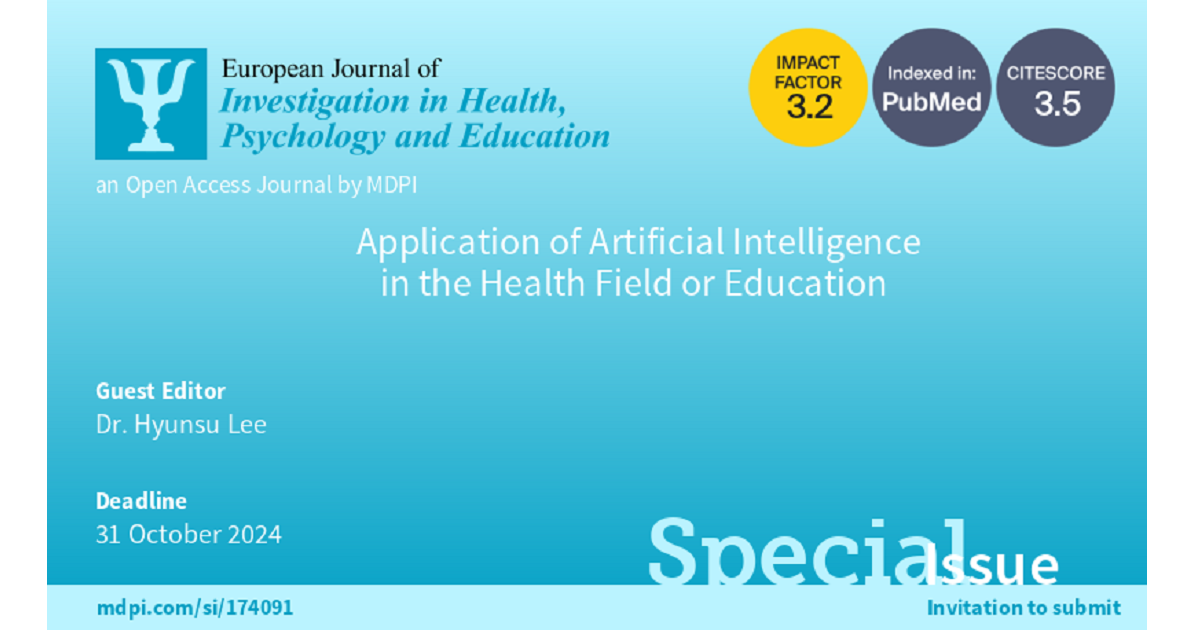Application of Artificial Intelligence in the Health Field or Education
A special issue of European Journal of Investigation in Health, Psychology and Education (ISSN 2254-9625).
Deadline for manuscript submissions: 31 October 2024 | Viewed by 16682

Special Issue Editor
Special Issue Information
Dear Colleagues,
Artificial intelligence (AI) has been making waves across various sectors, and the fields of health and education are no exception. The application of AI in these domains has opened up a plethora of opportunities, paving the way for innovative solutions and transformative practices. In this context, this Special Issue aims to delve into the latest research, trends, and applications of AI in health and education.
This Special Issue will serve as a global platform for exploring the diverse aspects that influence the application of AI in health and education. We aim to discuss innovations in health diagnostics and treatment, personalized learning experiences, new educational management systems, and the evolving landscape of health and education in the era of AI.
We invite original research contributions from authors worldwide. We welcome research papers, case studies, and demonstrations that present original scientific results. Specifically, we are interested in empirical studies in health and education regarding the use of AI technologies, case studies about AI applications in these fields, new health and educational management systems leveraging AI, new evaluation techniques and tools, and best practices in AI for health and education.
We look forward to your valuable contributions to this Special Issue and to the ongoing discourse on the transformative potential of AI in health and education.
Best Regards,
Dr. Hyunsu Lee
Guest Editor
Manuscript Submission Information
Manuscripts should be submitted online at www.mdpi.com by registering and logging in to this website. Once you are registered, click here to go to the submission form. Manuscripts can be submitted until the deadline. All submissions that pass pre-check are peer-reviewed. Accepted papers will be published continuously in the journal (as soon as accepted) and will be listed together on the special issue website. Research articles, review articles as well as short communications are invited. For planned papers, a title and short abstract (about 100 words) can be sent to the Editorial Office for announcement on this website.
Submitted manuscripts should not have been published previously, nor be under consideration for publication elsewhere (except conference proceedings papers). All manuscripts are thoroughly refereed through a single-blind peer-review process. A guide for authors and other relevant information for submission of manuscripts is available on the Instructions for Authors page. European Journal of Investigation in Health, Psychology and Education is an international peer-reviewed open access monthly journal published by MDPI.
Please visit the Instructions for Authors page before submitting a manuscript. The Article Processing Charge (APC) for publication in this open access journal is 1400 CHF (Swiss Francs). Submitted papers should be well formatted and use good English. Authors may use MDPI's English editing service prior to publication or during author revisions.
Keywords
- artificial intelligence
- AI practices for healthcare and education
- innovation in health diagnostics and treatment
- personalized learning experiences
- new health and educational management systems leveraged by AI
- novel evaluation techniques and tools






